Physics in Life Sciences
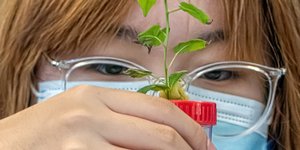
How does a laser work and how can we use it as a tool to watch individual proteins at work and even manipulate them? What is fluorescence and how does it help to better understand biological processes in cells? Why can the actually dangerous radiation from radioactive substances help treat cancer? In this course you will learn which physical methods are used to answer questions in the life sciences. We will work on these and other topics both in XLAB's own laboratories and together with scientists in their research institutes on the campus.
Laser Physics
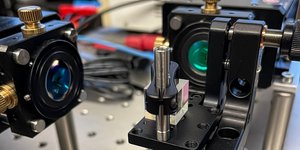
Lasers emerged from the first quantum revolution and are used in many areas of society. Numerous applications in data transmission, medicine, materials processing, and science benefit from the extraordinary properties of light emitted by lasers. In the second quantum revolution, lasers are now used as versatile tools for precise control and manipulation of individual quantum objects in quantum computing and communication. In the international science camp course on laser physics, you will experience the fascinating science of lasers. You will set up different laser systems, investigate the underlying laws of the quantum world, and learn about applications of lasers. The experimental course focusses on lab work, accompanied by physical modelling and fundamental simulations. Excursions and talks will give you insights into research and applications in the field of laser physics.
Light and Matter
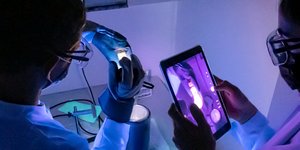
In this course, you will learn how scientists use the interaction of light and matter to generate light and colors by chemical processes, up to building an organic light-emitting diode (OLED) yourself. We will also investigate chemical reactions driven by light, such as a photocatalytic model system for photosynthesis. We construct an organic photovoltaic cell to generate electricity and use molecular switch systems to investigate how self-tinting glasses work, for example. In addition, researchers who use the interaction of light and matter will report on their work.
Plastics: Production and Sustainability
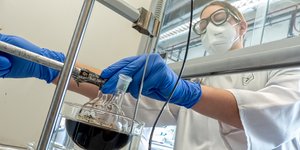
Plastic is a double-edged sword: irreplaceable in medicine and other applications, but problematic in terms of production and disposal. In this course, we will investigate the production chains of petroleum-based plastics (e.g. PVC) and plastics based on renewable raw materials (e.g. wood). In addition to fractional distillation, catalytic cracking and decomposition by boiling under reflux, we perform modern analyses like mass spectrometry and gas chromatography. To analyse microparticles formed by decaying plastic, you detect them by fluorescence staining. If plastic waste is collected properly, however, it can be reprocessed with added value. We will produce nonwoven microfiber mashes that are used in modern filter systems by electrospinning. Basic knowledge of organic chemistry and laboratory techniques is recommended.
Molecular Medicine
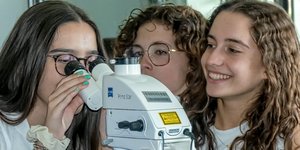
How does basic research actually work? How can crises such as the emergence of antibiotic resistance be overcome in future with the help of biotechnological tools? Will it soon be possible to transplant organs grown in a petri dish into humans? The focus of this course is on DNA and protein techniques, plus CRISPR Cas plays a big role. This course also includes a touch of immunobiology. You will perform common and state-of-the-art molecular methods and learn how to plan and evaluate experiments such as CRISPR/Cas, bacteriophage isolation, immunochemistry, ELISA, leukocyte differentiation, DNA profiling and gene expression studies. A visit to a research laboratory of the University Medical Center Göttingen will round off the topic.
Lake Ecosystems: Function and Sustainability
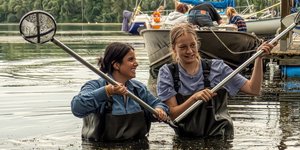
Lakes host significant biodiversity and provide vital ecosystem services that support the livelihoods of hundreds of millions of people worldwide. However, these services are declining due to stressors such as climate change, eutrophication, and overuse. For example, a quarter of the global population lives in the catchment areas of drying lakes.
In this course, you will investigate lake ecosystems through hypothesis-driven research. Using professional equipment, you will collect vertical profiles of physico-chemical parameters and phytoplankton biomass, analyze nutrient concentrations, and identify plankton under the microscope to explore their lifestyles and ecological roles.
You will learn how lakes function as ecosystems and how their productivity and stability are shaped by interactions between lake characteristics (e.g., size, depth) and catchment features (e.g., area size, land use). You will also develop ideas for sustainable lake management.
Neurobiology

The high performance of our nervous system is based on a fundamental principle: the formation and controlled change of an electrical potential at the cell membranes of the neurons. In this course, we will analyze the resting membrane potential of individual cells as well as active and passive potential changes. We will learn how we can influence the membrane potential chemically and electrically and conclude what this means for the function of our nervous system. As an example of a sensory system, we will compare the visual system of humans and grasshoppers using self-experiments and electroretinograms (ERGs) of the insect eye. For this purpose, we will determine the flicker fusion frequency and analyze the spectral sensitivity of the locust eye. The central nervous processing of visual stimuli is investigated with extracellular recordings from the neck connectives of the migratory locust.